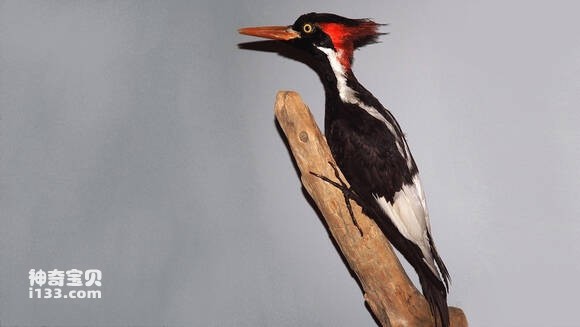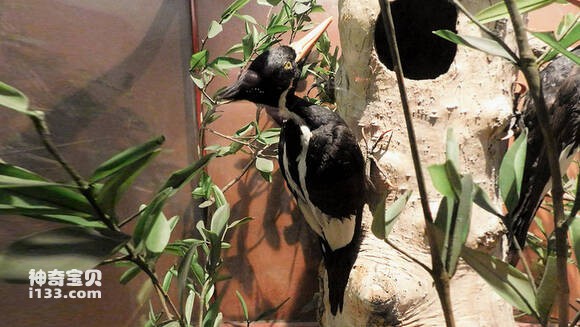Campephilus principalis
IUCN
LCBasic Information
Scientific classification
- name:Campephilus principalis
- Scientific Name:Campephilus principalis,Ivory-billed woodpecker
- Outline:Climbing birds
- Family:
Vital signs
- length:48-53 cm
- Weight:There are currently no research materials available
- lifetime:There are currently no research materials available
Feature
It is the second largest woodpecker in the world and the largest woodpecker in North America
Distribution and Habitat
The ivory billed woodpecker is distributed in the southeastern United States and Cuba.
The ivory billed woodpecker inhabits various evergreen broad-leaved forests or mixed forests. It has been found in various forest types ranging from swamps to mountain forests in Florida, USA, and also inhabits the Masson pine forests in the mountainous areas of Cuba. Originally living in lowland hardwood and mountain pine forests, mixed broad-leaved forests, and other forests in the United States and Cuba. Historical records indicate that they were once a very large family with low natural density, indicating the need for large contiguous mature forests to support a feasible quantity (Jackson, 2002). The vast forest area includes several different types of swamps and broad-leaved forests (Fitzpatrick et al. 2005), with a total area of approximately 220000 hectares. In Cuba, the widespread loss and degradation of lowland forests in habitats means that any remaining birds may be limited to intact m
Appearance
The body length is 48-53 centimeters, with a wingspan of approximately 84 centimeters. This woodpecker looks like a "nobleman" on the outside. They are tall, with ivory beaks, pale lemon yellow irises, clear black and white stripes, unique ridges, and a slender appearance that sets them apart. The bird's body feathers are bright black with white patterns, and its wings have white spots, named after its large ivory like mouth. The crown of male woodpeckers appears bright red. The neck and back are blue black with white stripes, and the chin is black. There are white edges on both the wing surface and bottom, and white edges in front of the wing bottom, forming a black line in the middle that gradually expands towards the wing end.
The beak of an adult bird is ivory colored, while that of a chick is chalky colored. There is a crown on the head, and the crowns of chicks and females are black. The front of the crown of males is black, and the back and sides are red. When
Details
The ivory billed woodpecker, also known as the Campephalus principalis or Ivory billed woodpecker, is the second largest woodpecker in the world and the largest in North America.

The ivory billed woodpecker mainly feeds on beetle larvae in dead trees, such as grubs and small cystic worms. Woodpeckers use their sturdy beaks to dig holes and reach the interior of trees where insects are hidden. Each woodpecker can carve a 12 centimeter deep hole in the dead wood in less than a minute. They also eat seeds, fruits, and other insects.
The ivory billed woodpecker is a monogamous bird that lives and migrates together. They mate around January to March every year. They will dig a nest 15 meters above the ground on a withered tree. Each time 1-4 eggs are laid, it takes about 3-5 weeks to hatch. Both parents will hatch eggs and take care of the chicks, with the male birds mainly responsible at night. After 5 weeks of birth, chicks will learn to fly, but their parents will still feed them for up to 2 months. In the next winter, chicks will leave their nests and live independently.
The ivory billed woodpecker experienced a significant decline in hunting numbers in the 1800s. In the 1920s, when two ivory billed woodpeckers were shot and killed in Colorado, it is generally believed that they had become extinct. In 1938, it was estimated that there were only 20 ivory billed woodpeckers left in the wild, with 6-8 of them in a private primitive forest in Louisiana. This forest was eventually cleared and deforested, and the last female ivory billed woodpecker died in 1944. There were multiple reports of ivory billed woodpeckers being heard from the 1940s to the 1990s, but none of them can be confirmed. They were listed as endangered in 1967 and extinct in 1994, but were later reclassified as endangered due to belief that they still exist.

On February 11, 2004, birdwatcher Gene Spalin traveled in a canoe and saw a bird he had never seen before along the White River in eastern Arkansas, USA. Spalin recorded the physical characteristics of this large bird and upon closer inspection, it turned out to be an ivory billed woodpecker that had disappeared for 60 years. After the news was released, it caused widespread shock in the biological community.
A week later, Tim Gallagher from Cornell Laboratories and Bobby Harrison from Oakwood University found Spalin. Under the leadership of Spalin, two ornithologists embarked on a journey to search for the ivory billed woodpecker. Next, more than 30 ornithologists divided into several research groups to take action, hoping to rediscover the ivory billed woodpecker. Over 30 ornithologists have discovered the trail of the ivory billed woodpecker 15 times during a 7000 hour search, and have taken numerous pictures and videos. After the approval of multiple experts from various countries, it has been determined that the ivory billed woodpecker is still alive on Earth. So, the American Society for Conservation of Nature applied to the government for conservation funds to protect the habitat of the ivory billed woodpecker and to use it for breeding research. Experts from the Cornell Ornithology Laboratory in New York and the Nature Conservation Association have kept the information confidential for over a year to protect the habitat of the woodpecker sanctuary, keeping it confidential from the outside world. The protected areas and bird watching areas have been established, and breeding research has begun. In order to help citizens better protect this rare bird species and attract more private conservation funds, experts have decided to disclose the information to the outside world.
Protect wild animals and eliminate wild game.
Maintaining ecological balance is everyone's responsibility!








